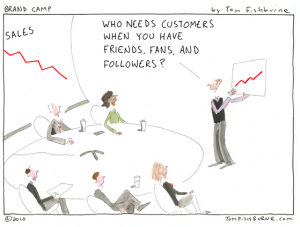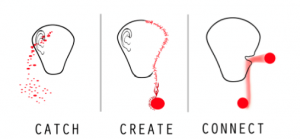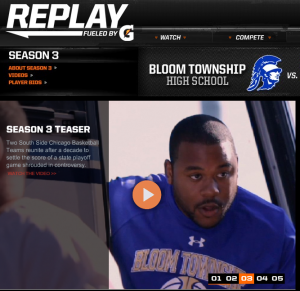Since writing my last post on the Old Spice campaign I couldn’t stop thinking about storytelling and branding.
It opens a question I find hard to answer:
is connecting with millions of potential customers through a fake funny story not useful?
Some people would say that these campaigns are great (Hollywood) storytelling creating fans and followers (probably not friends… but who believes the difference is important?). Can you blame them? I also like the entertainment factor of brand stories, so shoot me! Still I am not considering bying the product… which makes me think of a fantastic cartoon of Tom Fishburne I tweeted the other day.

Yes, finding real engagement with your audience (employees or customers) starts with sharing authentic stories … with tapping into conversations….and all of that digital content marketing stuff I like a lot.
Still I have always found it hard to argue that a broadcasted brand story like Old Spice is not worthy of your attention. Most of today’s customers enjoy a “good” Old Spice Story and are not necessarily looking for in-depth connections with the company or trying to establish deep relationships.
I believe it would be all too easy to say that brand storytelling still is all about ‘the power of the big creative idea’ and that the power of true storytelling and narrative only works for b-to-b communication (hey, does that name actually still exist?) and internal branding.
is connecting with millions of potential customers through a fake funny story not useful?
This weekend I tried to forget all about this question and decided to go for a run. Trying to clear my head. I usually do a 45 minute work-out. Unfortunately I discovered Mitch Joel’s latest podcast (an interview with Avinash Kaushik) on the “Extinction of the Marketing Dinosaur“) just 10 minutes before I wanted to start my run. Mmmm…. I decided trying to clear my head with Mitch Joel on (read: in) it. A good choice for my inspiration, a bad choice for my head.
I did do the 45 minutes but I constantly regretted not having brought pen and paper. So when I got home I immediately re-listened some parts of the episode and made some notes:
“…put your stories on many channels so they become symbiotic…”
Mitch discusses with Avinash the split of broadcasted advertising and content/digital marketing. Listen to the podcast, you’ll enjoy it.
I listened to it with storytelling-ears. These were some brand story questions I came up with after my run:
-Does your brand suffer from a split between the brand advertising story and the conversational stories around the brand?
-Does your brand have a clear core story?
-Does story show the real DNA of the brand?
And for the Old Spice campaign; does the advertising campaign show what the brand is made of? And do customers care about this?
I believe they do.
On the Mitch Joel podcast Avinash tells this short story of how he had a really bad internet experience with a big airline he frequently uses for his international flights; how this experience colors his feelings about the whole brand; and how he feels like telling the world about what he just had gone through.
Just like that. Today anyone can challenge carefully constructed brand stories online by sharing their experience online. Today there is a shift from brands broadcasting to consumers to a position where brands listen to the stories consumers are already telling.
Can brands no longer sell products and services by broadcasting their cleverly designed messages?
Of course they can. After my run I decided to spend the rest of the afternoon on figuring out how. Here is what I have been brewing on; it is the start of a brand-story-model (please have a go at it and mail me what you think about it).

Working your Brand Story: Catch, Create and Connect Stories!
- CATCH/
Is all about “experience”: how stories reveal themselves in moments/things that happen and in the bigger story around it. Through Story-listening you can uncover the stories that live inside or outside the brand.
- CREATE/
Is all about “entertainment”: how does the story make you feel about you, the brand and its values and beliefs. Through Story-design you can bring your brand to live.
- CONNECT/
Is all about “engagement”: how does the story foster participation with the community? Through Story-telling you can engage with your community (communities are a web of stories).
Which brings me back to me original question:
is connecting with millions of potential customers through a fake funny story not useful?
And with my little Catch-Create-Connect-Model in mind I can easily and honestly answer: no, it still is useful! But if you want to go all the way make sure your brand not only works on the “design” of the story (CREATE/) but also on the “experience” (CATCH/) and the “engagement” (CONNECT/).
Let me give some examples from brand who I believe have been working all three C’s:

The award winning Gatorade Replay campaign is a brilliant example of not only “designing your story” (CREATE/) but also working the two other C’s (CATCH/CONNECT).
It uses multiple channels to tell stories around a central theme. Like all the best stories the premise is simple yet compelling. But what makes the campaign so extraordinary is the level of audience engagement and how the audience participates in the creation of the story.
I believe it is a great example of brand storytelling. It is one of the best practices from the ad agency TBWA\Chiat\Day, LA, USA and winner of the Cannes Lions Grand Prix for PR and Promo and Activation.
Here is the campaign
The makers of this story wanted to weave the DNA of the brand into the DNA of culture to find more authentic connections with their audience. With the story they wanted to allow people to experience what Gatorade stands – A Catalyst for Athletic Achievement. And they wanted to demonstrate Gatorade’s bigger story – Fueling Athletic Performance.
What becomes clear to me with these examples is that brands need to reject the approach of only broadcasting a story for the sake of it. Stories are not toys that a brand can use to position itself into. Building brand value through storytelling does not happen with 1 single ad campaign. And like anything good, it takes trust to create something meaningful with your customers. But if you can make real connections and go to the heart of your community, you can build a better brand.



